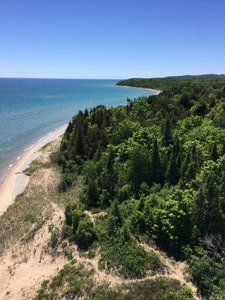Advertisement
Published: June 14th 2018

 B45C16D2-BC97-43E5-B3CA-16305B10997F.
B45C16D2-BC97-43E5-B3CA-16305B10997F.
South Manitou Island from the LighthouseSouth Manitou Island, Sleeping Bear Dunes National Lakeshore, Leland, Michigan
I mentioned in an earlier post, how the two bear cubs drowned as they tried to swim across Lake Michigan with their Mother. After dying, their bodies bobbed to the surface to form what we know today as North and South Manitou Islands. These islands are an integral part of the park and to understand the park, and view it from a different perspective, a visitor needs to spend at least a day out here.
Possibly you can get there by seaplane, but the usual method is by ferry boats which all leave from Leland, Michigan, a small fishing/tourist village north of the park boundaries. It isn’t a big ferry boat, but it seems that it is usually full up so reservations are a must. And, at least at this time of the year, the boat doesn’t run every day and when it does, there is just one trip, leaving precisely at 10:00 AM. Weather conditions can cancel the trip. On rare occasions, weather changes have stranded visitors on the islands for a day or two longer than they expected. Park rangers have planned for that and have extra

 EF3626AD-29A6-4B97-99CB-9D612BE56868.
EF3626AD-29A6-4B97-99CB-9D612BE56868.
From the Harbor Looking Out to the Lakefood stored away in case they have to feed a boat load of tourists for a day or two. One ranger told the story of two women who went out on a day trip and even though they were told that the boat left at 4:00, they spent extra time exploring a remote beach. They had assumed they could catch the next boat and were quite surprised when the returned to the dock and were told the next boat wasn’t for two days. They were bridesmaids in a wedding that was supposed to happen the next morning and so the rangers had to radio ashore and help them arrange a chartered fishing boat to come pick them up. They made their wedding appearance, but it cost them several hundred dollars extra!
We made our reservations on line several days early and, at that late date, we only had one day to choose from, yesterday - all other days this week were full up. The forecast called for an early morning rain shower, but it was supposed to lift, the sun was to shine, and temps were still mild. The forecast came true exactly and it was a beautiful day
for an island getaway. We checked in around 9:15 and gathered our gear for the day and put it on the ferry. There are no services on the islands, except water and bathrooms, so you have to bring your own food, bug spray, sunscreen, and layers of clothing. Unfortunately, they don’t sell coffee on the boat (although they do sell Bloody Mary’s and beer), so I picked up some coffee to go at a local store before boarding.
When we left, it was overcast and the water was choppy with whitecaps. The boat was bouncing around a bit. As we progressed westward, though, the clouds lifted, as promised, the sky turned blue and the waves calmed. It was a very pleasant boat ride. Once again, it is impossible to convey just how big the Great Lakes are, but being on a boat out on one of them is not very different from being on the ocean. Last year, in the Gulf and along the Atlantic outer islands, we rode several ferries. This trip was no different from them - the boat rocked and tossed, the spray rolled across the bow and into the faces of the brave, or foolish,
souls who stood in the bow, and the crew managed the boat exactly like similar crews managed the ocean going ferries. The only difference I could detect was that the ocean spray lacked the salty tang. Although there are other reasons not to drink untreated Lake water, salt is not one of them.
After about 45 minutes, we started to approach the dock of North Manitou Island. This is the larger island and has been declared a wilderness area. There are a few rangers on the island, but mostly this is for backpacking campers who want to camp in a totally undeveloped area. There were several hearty souls on our boat who were headed for that experience, most of them part of a church group that was headed to the island for a four day camping trip. That is what Joan and I call ‘real camping’ and is really beyond our capacities at this point. I can imagine, though, that if you have the youth and the equipment to do such a thing, it would be a wonderful time.
After dropping off the backcountry campers and picking up some folks who were finishing their camping trip, we proceeded
on to the South Island. This one is developed for tourists like us, with multiple rangers and park volunteers who live full time on the island and whose job is to greet new arrivals and help them see the sites. There are campgrounds here too, but they are more developed with fire pits and tent pads. (Alas, they don’t allow RVs - or dogs - onto the island, so this isn’t our style of camping either.)
After arrival, we proceeded to an array of picnic benches and ate our picnic lunch, sandwiches we had made earlier that morning, some carrots, and cookies for dessert. We washed it all down with cans of ginger beer. While we ate, we were able to survey the ‘Village’ part of the island and figure out where we were going to go next.
The same people that operate the ferry boat, also offer ‘motorized tours’ of parts of the island. A small tractor pulls a flatbed trailer that has been outfitted with seats. it holds about 20 people. We signed up for one of these tours, although you can also strike out on your own and hike anywhere you want to go on
the island.
Our trip started with an explanation that the buildings around us were part of the original United States Life Saving Service station that was established on the island to respond to shipwrecks in the Manitou Straits, between the islands and the mainland, during the late 1800s. Although the numbers are uncertain, there are more than a hundred wrecks in these waters, so the Life Saving Service was an active one, especially around the turn of the 20th century. Nowadays, the park rangers and volunteers live in these buildings.
Then the tractor, pulling us over a dirt path, headed into the woods. We went well over two miles and the woods became thicker and thicker. So did the mosquitoes. Even those with bug spray were fighting the mosquitoes off. A video of the group would have been hilarious with everyone’s arms swinging wildly, most of the time. The audio would have recorded slap after slap. The tour guides, young college-age guys, said that the mosquitoes had hatched recently, and this was the worst they had seen them. I think it made everyone hurry up.
After a couple miles of slow driving through the trees and bugs,
we came to a turnaround and stopped. Now we had to walk another quarter mile to our first attraction - an even denser stand of trees and bugs. We eventually encountered a boardwalk and shuffled past more pools of water, all the while, swatting bugs. The destination was a stand of old-growth cedar trees, among the largest on the continent. Because of the density of the swamp, these trees missed being cut down in earlier centuries and so are truly old. Some of them are estimated at around 600 years of age. One of them, with a circumference of thirteen feet used to be the largest living cedar tree known to man. Unfortunately, a storm toppled the top half of the tree and it is now dead. The official record now appears to belong to some tree in New York. The significance of these old and big trees is not their age or size, it is rather that they serve as a reminder of what these forests might have looked like had we not cut down everything in sight - an example of the majesty of nature.
Everyone more or less ran back to the vehicle, rather than walk,
just to minimize the bug bites. And then we proceeded to the next stop on the tour, which was just another path to walk down. This time, though, it opened up on the shores of the island and there, just off the beach was the remains of a 1960 shipwreck. The rusting hulk now serves as a resting stop for birds. I guess scuba divers can explore it as well, although the park service says it is fairly dangerous. Once again, the wreck serves as a stark visual clue as to how violent this expanse of water can get - these lakes are not to be trifled with.
Again we jogged back to the vehicle, battling the bugs all the way. And we proceeded back to the village. Next stop was the lighthouse. We had seen lighthouses last year especially along the Outer Banks of North Carolina. This lighthouse wasn’t nearly as tall as those, but still, even the need for a lighthouse was something unexpected. We climbed the 117 stairs to the top and, from up there, we were able to clearly see the sights of the island, as well as the Sleeping Bear Dunes some ten or
twelve miles away. A truly gorgeous view on a perfect day.
After spending time talking to the Park Service Volunteer who was running the lighthouse tour, a knowledgeable and entertaining man who clearly loves his job, we returned to the dock to catch our 4:00 PM return trip. Settling in with one of those Bloody Mary’s, we had a delightful boat ride back to shore, sharing our travel experiences with the others around us. It was a terrific day and an essential part of understanding this park.
(As an aside, neither Joan, myself, nor some of the park rangers can possibly imagine what the camping experience is going to be on those islands with the mosquitoes like they are. Although they are probably worse than usual this year, if you camp on these islands, be prepared for bugs!)
Advertisement
Tot: 0.385s; Tpl: 0.013s; cc: 12; qc: 46; dbt: 0.2574s; 1; m:domysql w:travelblog (10.17.0.13); sld: 1;
; mem: 1.1mb













